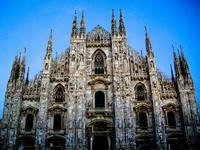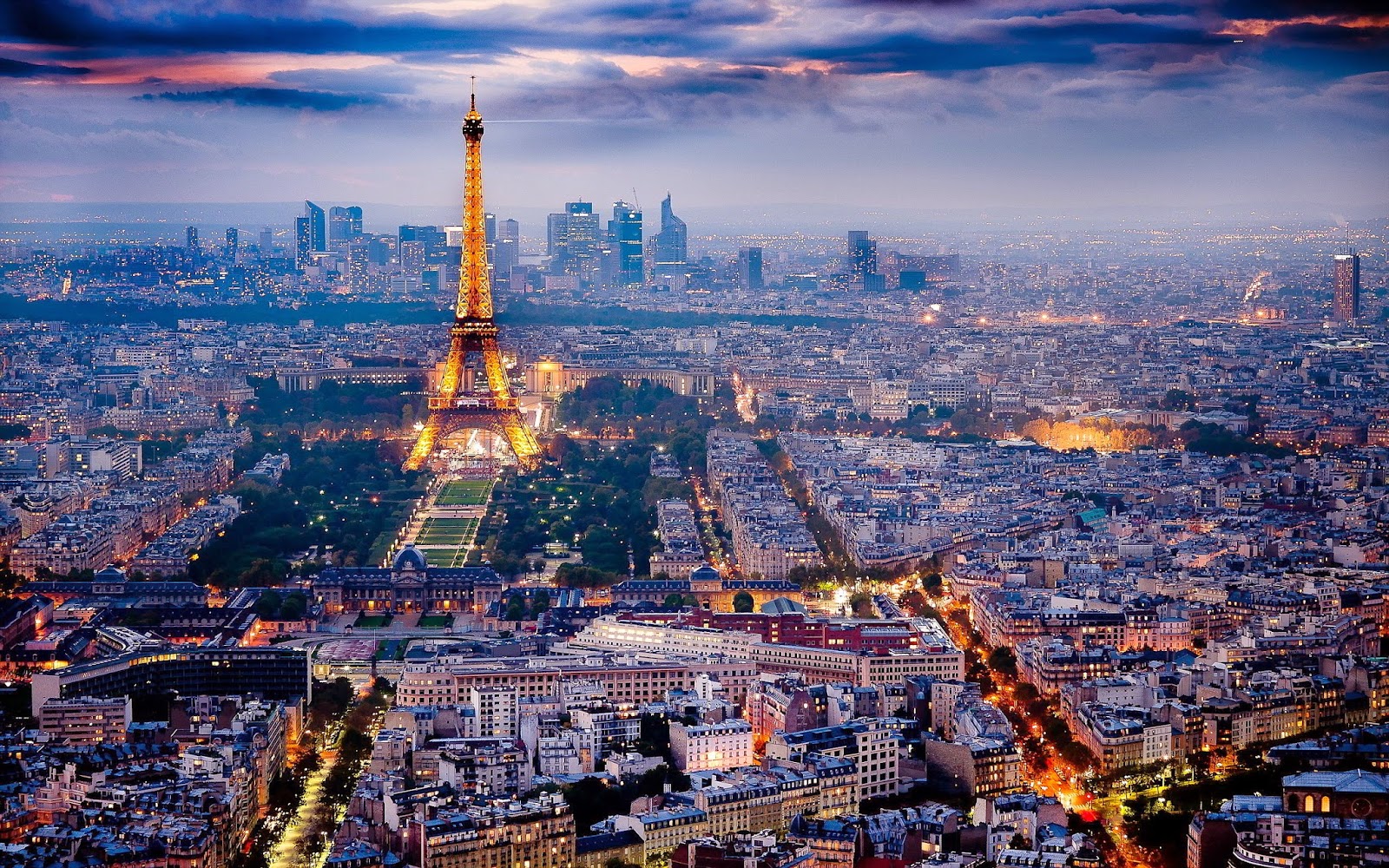MILAN CITY
Metropolitan cities in Italy
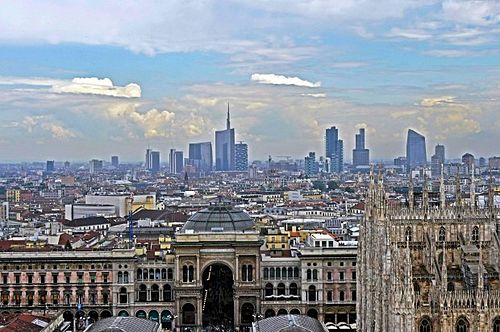
Milan
(Italian: Milano) is the second largest city in Italy, located in the Lombardy
region. It is the capital of the province in the Province of Milan, as well as
the capital of the Lombardy region. The Milan metropolitan area, is now the
largest in Italy, is estimated to have 7.4 million people by the OECD.
Milan is
renowned as one of the country's capital of design and fashion. Millinery
English word, referring to women's hats, derived from the name of the city.
Lombard metropolis is famous for its fashion houses and shops (such as Via
Montenapoleone) and the Galleria Vittorio Emanuele in the Piazza Duomo
(arguably the oldest shopping centre in the world). The city hosted the World
Exposition in 1906, and will host the Universal Expo in 2015. Residents of
Milan are referred to as "Milanese".
Milan area
located in the Padan Plain in the west-central region, including between the
rivers Ticino and Adda, among the river Po and the first relief Alps. It has a
surface area of 181 km2 and is 122 meters above sea level.
MOST ATTRACTION PLACE
1. Duomo
Patience can turn out to be a beautiful experience as with Duomo, the fourth largest and opulent Gothic cathedral whose construction was spread over five centuries until Napolean came into the picture and ordered it to be completed in 1809. The spot on which it is erected is famously known as Piazza Duomo and has been sacred for the Basilica of Santa Maria Maggiore. Duomo was the enterprise of Gian Galeazzo Visconti who donated the bricks & marble that beautifies the cathedral and forms the main part of its structure.
The inspiring cathedral is Italy’s last Gothic works and is accentuated by 135 brilliant marble spires, 3,400 statues and 96 gargoyles that transport us back to the medieval times. When visited during the summer, the sunshine as it filters through the stained glass mosaic windows embodies the 40,000 church worshippers with the feelings of belief, faith, religion and culture. The inside of the cathedral is as grand and spacious as the Visconti family would have liked it be. The nave which touches a height of 45 meters is the highest for any cathedral. Divided into five aisles, the cathedral houses the tomb of Gian Giacomo Medici, its most important benefactor. Every May and September the cathedral puts on view a nail from the cross of Christ for which thousands of devout Christians from all over the world visit the Duomo. Each and every nook and corner of cathedral is worth viewing and its work of art to be praised. The kind of artistic decoration that the structure has been endowed with is nowhere to be seen today.
Opening Hours: Duomo: daily 6:50am-7pm. Roof: daily 7am-7pm. Crypt: daily 9am-noon and 2:30-6pm. Baptistery: Tues-Sun 10am-noon and 3-5pm.
Address: Via Arcivescovada 1 - 20122 Milano, Italy
2. Teatro alla Scala
If opera was to be known by any other name, then it would have to be by Teatro alla Scala, the world’s largest opera house. Built in 1776 Giuseppe Piermarini on the site of Church of Santa Maria alla Scala it is a witness to the first steps of operas when it didn’t assume much importance. Later on opera donned on a romantic endeavor and was rightly successful in it under the guidance of Ferdinando Paer and Giovanni Simone Mayr. In 1943, during World War II it was badly bombed but was restructured later. Along with the theatre today, it also accommodates the Museo del Teatro and La Scala's Ballet School.
Opening Hours: Daily 9am to 12.30pm and 1.30pm to 5.30pm
Address: Via Filodrammatici 2 - 20121 Milano, Italy
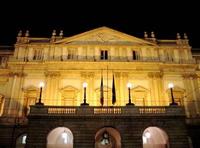
3. Stadio San Siro
Stadio San Siro, Milan’s central football stadiums where all fanatic sports fans gather together for their favorite match, has been named after their eminent Milanese footballer Giuseppe Meazza. Inaugurated in 1926, constant renovations and reconstructions have led to increase in its capacity of accommodating more that 85,000 visitors. An interesting fact; its design has been put on paper by Leonardo da Vinci but he himself could not complete the dream of constructing it himself.
Address: Via Piccolomini, 5 – 20151 Milano, Italy
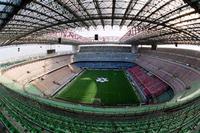
4. Cimitero Monumentale di Milano (Cemetery)
Cimitero Monumentale di Milano is an important cemetery in Milan occupying a spot by the same name of Piazzale del Cimitero Monumentale. Going back in 1866, its 250,000 sq.mtrs of area are a silent spectator to various burials of distinguished people, over the years. The main highlight of the cemetery is the House of Fame or Famedio whose resembles to Pantheon is uncanny but is historically important as it’s the burial place of important persons.
Opening Hours: Tuesday to Sunday 8.00am to 6.00pm, Every Monday, 1st January, Easter, Easter Monday, 1st May, 2nd June, 15th August, 8th, 25th and 26th December closed
Address: Piazzale Cimitero Monumentale, Milan, Italy
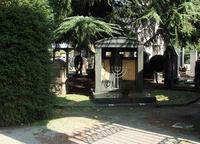
5. Basilica of Sant'Ambrogio
Basilica of Sant'Ambrogio is dedicated to 3rd century Saint Ambrose who served as the Bishop of Milan during his times. The architecture of the basilica has been noted due to its medieval façade, but during consequent centuries it has been renovated and re-built many times giving its design a Romanesque touch. Today what remains is the Romanesque Basilica originating from the renovations carried out in the 11th century. Among all its intricate carvings the most notable are the Nave, large marble ambo, Sarcophagus of Stililchone, Golden Altar and Ciborium, Apse Mosaic and most important of all, crypt of St. Ambrose where the Saint Ambrose and St. Gervasius and Protasius are carefully kept, donned in typical bishops attire.
Opening Hours: Mon-Sat: 7am–noon, 3–7pm, Sun: 7am–1pm, 3–8pm
Address: Piazza Sant'Ambrogio, 15 - 20123 Milano, Italy

6. Santa Maria delle Grazie
Listed under World UNESCO Heritage sites, Santa Maria delle Grazie is a church and convent in Milan with an architectural design that is a core part of the Renaissance era along with the presence of the masterpiece painting of Leonardo da Vinci-The Last Supper. Between 1466 and 1490 the foundations of the church were laid by Guiniforte Solari with the apsidal part being added on later by Bramate. The north wall is embedded by Leonardo da Vinci’s painting: The Last Supper painted between 1495 and 1497, which portrays Jesus’s last supper before his death. In this work of art, Jesus last words include that one of his disciples (Twelve Apostles) is going to betray him.
Opening Hours: Tues.-Sun. 8-7:30, last entry 6:45
Address: Piazza Santa Maria delle Grazie 2, off Corso Magenta, Sant'Ambrogio, Milan, Italy

7. Triennale of Milan
Since its origins in 1923 Triennale of Milan has been the centre point for designers with intense creative collaboration going on between the fields of industrial arts, designing and applied arts in Palazzo dell'Arte. The name which suggests, “three times a year” when translated has been holding various exhibitions from 1980 displaying various kinds of furniture, architecture, etc.
Address: Viale Alemagna, 6 - 20121 Milano, Italy
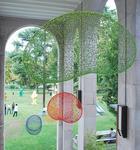
8. Lake Como
One of the largest and deepest lakes in Italy, Lake Como is just 40 kms north of Milan and is famous for its villas, picturesque mountains and valleys and the constant influx of Hollywood celebrities. Leisure facilities like golf, tennis, squash, skiing, sailing & water sports are available in abundance while highlights include various grandly decorated villas of hi-profile celebrities such as George Clooney, etc.

9. Arco della Pace
The Arco della Pace; one of the foremost Neo-classical monuments in Milan comprises of two tall statues located in the area of Corso Sempione near the park by the same name. The structure was constructed as a commemoration to Napolean’s victories. Construction which began in 1807 was followed by many glitches but was over by 1838 under the rule of Austrian Emperor Ferdinando. It became a testimony to the independence of Italy and the inscriptions of the Austrian rulers were promptly overwritten.
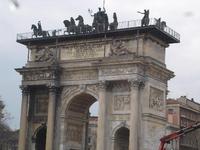
MILANESE CUISINE
Italy is, of course, widely known for its cousine. However, but some cheeses that go under the radar include tasty and sometimes spicy varieties like taleggio, stracchino, gorgonzola. In general, the most important things to try in Milan (and the whole of Lombardy) include milk, cream, butter, cheese. It may sound strange, but it's true. A great majority of the classic dishes consist of milk and cream, butter, mascarpone, cheese and ricotta, even the names of the towns, such as Crema and Cremona remind you cheese. However don't think that everything's the same and tastes the same: there is a huge variety in the rich cuisine of Milan. Rice tends to be more popular than pasta and, in fact, rice absorb more cheese butter and broth. Sometimes they even throw vegetables or meat into the mix. However, pasta is quite important here as well with dishes such as "tortelli di zucca", which is ravioli stuffed with pumpkin, and "pinzoccheri," which consists of buckwheat noodles cooked with potatoes cabbage and cheese. Don't forget the soups: "zuppa pavese" (broth with bread and eggs) and "zuppa di porri e bietole" (made with leeks and swiss chard). Another typical meal is "polenta", topped with mushrooms or meat- a rich dish typically served during the winter. Finally, what about meat? Here you are "bresaola" dried beef; "carpaccio" thinly sliced raw beef; "arrosto" roast meat such as beef pork or veal and sausages. These meals are served with side dishes such as beans, mushrooms, or salad.
1. LA BUSECA – The Milan Tripe
The term "buseca" refers to the stomache of a cow- also known by its more gentle term, tripe. They thoroughly cleanse the tripe under cool running water, and place it to cook in a pot of boiling water so it begins to become tender. Next, Brown some butter, onions, sage and bay leaves in a frying pan. Add the tripe with a half cup of white wine to the frying pan. Then pour some hot broth and a little tomato sauce in the frying pan. Salt and pepper to taste and cook slowly for two hours. In a seperate pot, bring 200gr of garbanzo beans to a boil. Next, add the garbanzo beans to the tripe 10 minutes before it is ready to be served. Sprinkle with parmesan cheese and enjoy!
2. LA CASSOEULA–A stew of meat and vegetables
Finely slice carrots, celery stalk and a small onion, and place them in a pot with some oil to gently sweat. Add pork ribs to brown over medium heat for about 15 minutes, then deglaze the pan with a bit of red wine. After the wine reduces, add tomato sauce and cover the pan to let it cook for 15 minutes more. While the ribs gently cook, wash the cabbage and break it with your hands (without using knife) and place it bit by bit to cook with the ribs- Replacing the cover to let it wilt. Repeat the same with the the rest of the cabbage until there is none left. If you prefer your cassoeula to be a bit more fluid, add one or two glasses of water. Let it sit to simmer for three hours, stirring occasionally.
3. LA COTOLETTA – The typical secondo
Flatten the veal cutlets out with the palm of your hands, put them in the flour and then in the beaten eggs. Then dredge the cutlets in bread crumbs, meanwhile heat olive-oil in a frying pan until hot. Add the cutlets to the frying pan and cook quickly turning once, so both sides brown. Serve hot garnished with parsley and a segment of lemon.
4. L'OSSOBUCO – The milanese speciality with "gremolata"
Dust each piece of veal shank with seasoned flour. Heat olive–oil, butter, garlic, onion and celery in a heavy–bottomed frying pan. Sweat for about 5 minutes- or until soft but not browned. Add the shanks to the pan and cook for 12–5 minutes, until well browned on all sides. Pour a half cup of white wine in the pan (add a cup of water if needed) cover it and cook for one hour, or until the meat is tender. To make the "gremolata" mix together lemon zest, parsley and garlic until it forms something of a paste or pesto. Before serving the shanks, garnish them to taste with the gremolata.
5. LA PICCATA MILANESE – Fried slices of chicken with sauce
Pound slices of chicken with a mallet if necessary to tenderize. Sprinkle with a little salt, dust with flour, then dip into beaten eggs and Parmesan cheese. Heat olive oil and sauté chicken until golden brown on both sides. Then remove from pan. To the same pan add mushrooms and ham and sauté until are soft. Remove the ham and mushrooms and discard all the liquid from the pan. Put the cutlets back into the pan and add the ham mushrooms a little broth and 1 tablespoon of butter. Simmer and shake occasionalliy the pan until the sauce is smooth. Remove cutlets from the pan and pour the sauce over. Sprinkle with chopped parsley.
6. IL RISOTTO ALLA MILANESE – The famous milanese first course "primo"
Il "risotto alla milanese" is a saffron risotto, and the traditional accompaniment to "ossobuco". RECIPE: In a large saucepan melt butter and cook the onions until traslucent. Pour a cup of white wine to deglaze the pan and continue cooking until it has reduced greatly. Add the rice and cook for two minutes. Add one cup of the boillig broth season with salt and stir. Continue adding broth as it evaporates, until rice is between "al dente" and tender - stirring constantly. A few minutes before rice is done add the reconstituted saffron and stir. Cover and leave the risotto for 5 minutes, dusting with Parmesan cheese before serving.
List of the most famous markets:
Mercatone del Naviglio Grande: It takes place each last Sunday of the month starting in September and it is situated along the Alzaia Naviglio Grande. This is an antiques market selling furniture, objects for the home, old books, jewelry etc. The market has 400 exhibitors, some of them have their own stores at the Naviglio Grande.
Fiera di Sinigaglia: The Fiera di Sinigaglia in Milan is now an institution: every Saturday morning in Viale d'Annunzio along the wharf there is a flea market. You can find everything there: Indian, South American and African craftwork, new and second-hand clothes, old furniture, perfumes, candles, books, comics, records, videos and DVDs.
Viale Papiniano: It is situated in Viale Papiniano, there are stands with brands as stocks and outlets. It is very popular and it offers food, plants, clothing, shoes and textiles too.
Viale Fauché: Very appreciated by the fashionistas. You can find discounted clothes and shoes of the most prestigious italian stylists.
Obej Obej
This famous event takes place every year from 7 to 10 of December in Milan. It is an open air market hosted in piazza Castello, around the Sforza Castle.
This celebration has very ancient origins, it started in late 1288 and was dedicated to St. Ambrose, the patron of the city. It is said that this name comes from the exclamations of joy of the children of Milan - “Oh belli! Oh belli!” that is to say "Oh beautiful! Oh beautiful!" - when in 1510 they were looking at the gifts that Pope Pio IV made bring to them by Giannetto Castiglioni.
The stalls of "Obej Obej" are full of Christmas objects and decorations, but they also collect toys, sculptures in wood, antiques, craft creations in wood, iron or cloth, vintage comics, jewelry and delicacies of this period such as anice brigidini - typical sweet waffle - strands of roasted chestnuts, delicious krapfen rolled in sugar, roasted cobs and all the types of nougat. Everything done to delight children...but also adults.
The tradition wants that people buy here their Christmas decorations, while eating chestnuts sold in stalls and defending from the bitter cold with a glass of sweet hot wine - called vin brulè.
Stalls are prepared during the evening of 6 December and they are open to visitors everyday from 8,30 a.m. to 9,00 p.m.
This famous event takes place every year from 7 to 10 of December in Milan. It is an open air market hosted in piazza Castello, around the Sforza Castle.
This celebration has very ancient origins, it started in late 1288 and was dedicated to St. Ambrose, the patron of the city. It is said that this name comes from the exclamations of joy of the children of Milan - “Oh belli! Oh belli!” that is to say "Oh beautiful! Oh beautiful!" - when in 1510 they were looking at the gifts that Pope Pio IV made bring to them by Giannetto Castiglioni.
The stalls of "Obej Obej" are full of Christmas objects and decorations, but they also collect toys, sculptures in wood, antiques, craft creations in wood, iron or cloth, vintage comics, jewelry and delicacies of this period such as anice brigidini - typical sweet waffle - strands of roasted chestnuts, delicious krapfen rolled in sugar, roasted cobs and all the types of nougat. Everything done to delight children...but also adults.
The tradition wants that people buy here their Christmas decorations, while eating chestnuts sold in stalls and defending from the bitter cold with a glass of sweet hot wine - called vin brulè.
Stalls are prepared during the evening of 6 December and they are open to visitors everyday from 8,30 a.m. to 9,00 p.m.
SHOPPING MALL

Known as the world capital for fashion and design, one could easily find fashion establishments and shops from the not-so-cheap to the most expensive, from the antique to the newly tailored-just-for-you type housed in most of Milan’s shopping malls.
1. Galleria Vittorio Emmanuel II.
The most famous of these shopping centers is the Il Salotto di Milano (Milan’s living room) or more famously known as the Galleria Vittorio Emmanuel II. Located at the heart of the city, on the northern side of Piazza del Duomo and adjacent to the Piazza della Scala, the grand structure was designed by famed neo-classical Architect Guiseppe Mengoni in the 1860’s. High-lighted by an awe-inspiring, glass-ceiling art, the Galleria Vittorio Emmanuel was made to be a formal covered arcade for early cafes and shops. At present, the world’s probably oldest mall offers anything: from books, paintings, expensive silverware and jewelry, what have you. The more chic brands such as Louis Vuitton, Prada, Gucci and Fendi have stores in the Galleria Vittorio Emmanuel as well. It is an elegant location to dine and shopwhere you can enjoy and feed your appetite for fine food and aesthetic beauty at the same time. So may it be strolling along the 18th century structure to window shop or simply sip a cup of hot steaming coffee while chatting with friends, dropping by the Galleria Vittorio Emmanuel is definitely worth your time. Just be aware that class comes with a price so expect to spend more than a few Euros than necessary.
2. Bonola Shopping Center
The Bonola shopping center can be found at northwestern Milan, not far from the soccer stadium. Finding this mall shouldn’t be too difficult since it is located between the Bonola and Uruguay underground stops wherein Bonola is a part of the red line, Milan’s oldest underground line. The Bonola shopping center is home to restaurants which serve sumptuous and authentic Italian and international cuisine, a hypermarket and two department stores which sell a wide variety of products such as computer goods, sports wear, hip teen clothing, do-it-yourself furniture, gardening supplies, and expensive men and ladies wear. Also within the modernly designed two-floor building made out of huge panels of mirror-looking steels are social service offices, banks, a medical center, and a library.
3. La Rinascente
Open seven days a week is the La Rinascente, a huge and upscale department store with eight floors, located at the city center near the Galleria Vittorio Emmanuel and the Piazza del Duomo. Jewelries, accessories, perfumes and watches are just some of the things you can find here aside from the fashionable men and ladies apparel. You can even get your hair done before going for an al fresco drink at the rooftop bar on the 7th floor.
4. 10 Corso Como
10 Corso Como is a thirteen square foot, multi-functional shopping complexwhich can be found at the outskirts of the city. Strategically located near the Centro Direzionale in the Garibaldi district, this lifestyle emporium showcases a photo and art gallery, a bookstore and some fashion shops to name a few. Its European/Oriental interior houses a café and a restaurant for those who prefer to dine rather than shop.
Still can’t get enough? Visit the malls near Milan such as Novate Milanese in Metropoli, CiniselloBalsamo in Auchan and Sesto San Giovanni in Vulcano for more good food, good sights and even better fashion!
